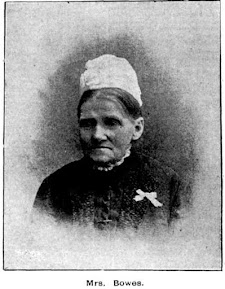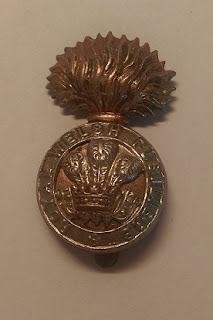A friend indeed!
Well, what a splendid medal result for Australia in Paris so now it's onward to the Paralympics starting later this month. Another event to load up the return plane with a lot of metal! I hope so.
I did not intend to publish another blog about a person whose origins were French, but this person ancestry was removed from that country via a few generations.
CHARLES EDWARD DE BOOS
Charles was born in May 1819 in London to Abraham Charles de Boos and his wife Mary Ann. He was the first of seven children. There is reputedly a link to a French Count but his 3 times Grandfather, Abraham de Boos was born in Normandy to a family of the Protestant faith who fled to England in the early 1700's to escape persecution in a Catholic France. The family like many other Huguenots settled in the Spitalfields area of east London and were heavily involved in aspects of the silk industry especially in relation to weaving cloth. Abraham married Madeliene Eude in 1716 in the French Huguenot Church in Threadneedle Church; her family had fled to England during the second wave of migration in the 1680's.
Charles was educated in Surrey and most likely in the East India Company Military Seminary where, besides studying military subjects he also received a sound education in the classics. In 1835-1837 he participated in the Cartist (civil) wars in Spain as a voluntary member of the British Auxiliary Legion that supported the Queen of Spain.
After the war he came to Sydney in 1839 and took up land on the Hunter River. Charles was not successful in that venture and became a journalist at the Sydney Gazette. In 1851 he went to Melbourne and was commissioned by the Argus to report on the Victorian goldfields. Charles spent five months at Ballarat and the area around Bendigo and in 1853 visited the Ovens Valley on a similar assignment. In 1854 he became a shorthand writer for the Victorian government and in 1856 Charles returned to Sydney and joined the Sydney Morning Herald. During Parliament recess he visited the NSW goldfields as a special reporter for the paper and reported on the recently discovered fields. The knowledge he acquired of mining, its laws and the needs of the miners was to be of great benefit to him.
Charles de Boos in later life - Hughenot Austrlia
Charles gave evidence before the 1870 royal commission on various aspects of the goldfields which led to him being appointed as mining warden in 1875 of the Southern Tumut and Adelong mining districts and later that year as a Magistrate. In 1879 he became warden for the Lachlan and in 1880 for the Hunter and Macleay mining districts. Charles was also appointed as Police Magistrate and coroner at Copeland.
In 1883 Charles ceased to be a mining warden but continued as Police Magistrate at Copeland until his retirement in June 1889.
In his role as mining warden, Charles dealt with the difficulties of Goldrush fever; the influx of many people almost overnight, their living conditions, petty arguments that developed into full scale riots and so on. Many of the people who came in search of gold were Chinese men. In 1861 there were about 13,000 Chinese in NSW with the vast majority on the goldfields and these numbers rose steadily. They attracted particular attention due to their distinctive features, clothing and language. Any admiration of their work ethic was offset by envy and resentment when times got hard and a number of anti-Chinese riots ensued such as Turon in 1853 and those in Lambing Flat and Nundle in 1860 and 1861. Initially seen as simply unusual, the Chinese became rivals and then threats to white Australia.
Chinese miners on the goldfields - Museum of History NSW
Despite the anti-Chinese feeling in sections of the community the law dealt with all nationalities. In his official role as mining warden and Police magistrate Charles ensured that the law was upheld and that no matter what the community felt in regard to the Chinese as a race, as individuals they were entitled to the same legal protection and penalties as everyone else.
Charles garnered much respect from the Chinese community and in 1881 was presented with a gold medal as a mark of esteem by Chinese miners in the Braidwood district. The money raised to present this rare medal came from Chinese miners all donating a pinch of gold dust. By having this medal in his possession, Charles could have travelled freely throughout China without question. He claimed it was one of his most treasured possessions.
Charles de Boos Chinese medals - Wikitree (part of the State Library NSW collection)
In retirement Charles published several short stories; he was a prominent Freemason and a member of the New Brunswick Grand Lodge. He died of senile decay in October 1900 at his daughter's home in Ryde. He was predeceased by his wife Sarah, whom he had married in 1848, two sons and three daughters and survived by all children but one son who had died in 1895.
He is buried in the Old Anglican area of the Cemetery in an unmarked grave. A sad end to a rather remarkable life.
I was at Rookwood sometime last year pulling weeds with the Gardening group when we were approached by a Chinese journalist who was seeking Charles' gravesite. I was happy to escort him to the plot and he was very disappointed to only see a grassy area. He said that Charles was a great friend to the Chinese gold miners, and he needed to at least have a small memorial. I couldn't help but agree. Maybe this might happen sometime in the future.
For my references today I have drawn information from ancestry.com, the Australian Dictionary of Biography by LV Holt 1972, Obituaries Australia, Trove, Wikipedia and the Migration Heritage Centre website.
If you have any insights to add or comments to make, please feel free to do so below or at the Group Facebook page found under
Rookwood Cemetery Discoveries
or simply send me a personal message via
lorainepunch@gmail.com







A wonderful story ! Sad that there isn’t a stone
ReplyDeleteYes I agree but there are many unmarked graves of particularly well-known people that would alarm you - I'll be posting about a few of them in the next few months
DeleteLove your stories
ReplyDeleteThank you! I love finding this for you to enjoy
Delete